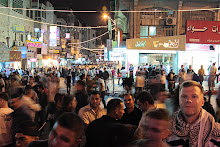So what am I talking about?
Alona Nitzan-Shiftan's chapter "Seizing locality in Jerusalem," from the title alone, would appear to a geographer as a very straightforward tract on how different groups claim space in the city. But, obviously, she wasn't writing it for geographers, because the chapter instead revolves around the co-opting of "traditional" (or "native") Palestinian architecture by a movement of Israeli architects. However, what Nitzan-Shiftan sees as an inversion of structure and form imposed upon the landscape--wherein conqueror takes up the symbols and methods of the conquered--is actually, to me, a straightforward co-opting of culture by a colonial power. We see numerous examples of this aping of indigenous culture by colonial powers, producing something hybridized and not truly "indigenous" or similar to culture in the imperial heartland. Look at the architecture of the British Raj in cities like Lahore, Delhi, and Calcutta; the "mission" style in the American southwest; the baths and seraglios created by Turks (Seljuk, Ottoman, Mamluke, etc.) in Arab cities like Cairo. The creation of a colonizer/colonized fusion of culture, often expressed in architecture, to me seems to be a common occurrence.
Nitzan-Shiftan reads the sabra movement, in its abandonment of Modernism and its taking up of an "Arab" ideal, as something of an unconscious colonial apologia--as Modernist architecture looked/felt alien to the landscape of the state of Israel, the sabra designers sought a more authentic, a more fitting style for the land. Of course, this "fit" and "authenticity" was expressed in the native dwellings of indigenous Palestinians, and so by taking up this more "authentic" style of design, the sabra architects were actually affirming the place of Arabs, the "belonging-ness" of Palestinians to the landscape.
Though maybe I'm reading too much into the chapter--Nitzan-Shiftan repeatedly alludes to sabra architects and their efforts as a "yearning to be 'of the place,'" that is, the form and design ideas aped native building (or evoked Biblical or Mediterranean themes) because of the dislocation of Diasporic Jewry, and the need for Israelis to feel at home in what was, to them, the ancient homeland they had lost. A more cynical reading might argue that this "yearning to be 'of the place'" is coterminous with a need to establish "facts on the ground," that is, the more "authentic" the look and feel of a community, the more valid one's claim to the land, stretching back to antiquity.
I've noticed that I'm using a lot of quotation marks, commas, and shifty, vague terms like "look" and "feel." And then, there in that sentence, I've done it again: more commas and more quotation marks. That's a central problem when we're dealing with something ans inchoate and slippery as "culture." And isn't architecture, in a very fundamental sense, an expression of culture? Taking up notions of how a nation should build and what suits the landscape as well as human function, and then creating tangible icons of the nation and how its people function--that is architecture. Based on, and reflecting... or perhaps refracting culture. Then again, what is "culture"? More slipperiness and ambiguity.
I will say this: architecture is both an expression of, and expressive to, a nation's culture. Israel today sees itself as a fusion of Occident and Orient, and this is at least partly due to the uptake of native and Western design. Sort of like Disney's Epcot Center, or the Strip in Las Vegas--where you can walk through little compartmentalized versions of a dozen different countries, each designated by a style of design and some recognizably "authentic" landmarks--you can make a place feel a certain way, simply by building that way. To be clearer: build a shopping mall with stone, throw a few arches and shady promenades, maybe a dome somewhere, and it is "Middle Eastern." The shopping mall doesn't have to be in the Middle East, or evoke the Middle East for any purpose other than to divert shoppers' imaginations, so they feel like they're buying an "authentic" Middle East experience instead of just a new pair of shoes. One shopping mall designed in such a fashion is a gimmick; a hundred shopping malls, apartment complexes, suburban communities, and governmental buildings designed this way create a cultural notion that the place is the Middle East.
And so it went with the sabra architects. They were as much creating a connection with the landscape as they were forging an Israeli identity, an identity of having one foot in the West and one in the East. I would argue we hear that identity expressed every time someone invokes Israel as "the only democracy in the Middle East." But that's a can of worms for another occasion.
Oh, one last bit on Nitzan-Shiftan: for anyone interested in doing a doctoral dissertation, take careful note of the last block of text from the lead paragraph on page 232:
Why should architects Israelize a contested city with architectural forms of another nation? Moreoever, once such espousal of the Palestinian vernacular took place, what were the mechanisms that enabled Israelis to separate it from the culture that produced it in order to make it constitutive of 'an Israeli architecture'?Those are research questions, folks--the big, sprawling, "what is going on?" and "under what conditions can this happen?" questions that you can build an entire dissertation around.


No comments:
Post a Comment